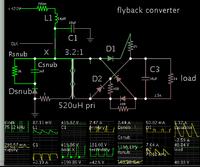T
treez
Guest

Hello
We have had a 100W Boundary Conduction Mode flyback LED driver SMPS designed for us by a consultancy and we believe they have messed up. What do you think?.....
The flyback is connected to the 420V output of a preceeding boost PFC stage.
The flybacks spec is….
Vin=420V
Vout=40V
Iout = 2.5A
L(pri) = 520uH
NP/NS = 3.2
F(sw) = 75KHz
Peak primary current at max load is 2.2A
Unfortunately I do not have the transformer spec, the consultancy are keeping this to themselves.
I do not know what is the leakage inductance in the transformer.
The problem is that the primary clamp/snubber consists of just an ES1J ultra fast diode feeding into a SMB size, 220V TVS. The TVS is on minimal pads. The TVS part number is SM6T220A
This seems miles too small for a 100W flyback.
Supposing that the leakage inductance was 1% of primary, ie 5.2uH, then…
The power dissipated due to the leakage inductance is 0.5*5.2e-6*(2.2^2) * 75000 = 950mW….however….
Since some of the flyback’s power current ends up unfortunately flowing into a flyback primary clamp, the power dissipation in this SMB TVS will be more than this.
Would you agree that a single 220V SMB size TVS is miles too small for the primary clamp of a 100W flyback as described?
ES1J diode datasheet:
https://www.fairchildsemi.com/datasheets/ES/ES1J.pdf
SM6T220A TVS datasheet
**broken link removed**
The flyback switching FET is FCPF1300N80Z (800V TO220 FET)
We have had a 100W Boundary Conduction Mode flyback LED driver SMPS designed for us by a consultancy and we believe they have messed up. What do you think?.....
The flyback is connected to the 420V output of a preceeding boost PFC stage.
The flybacks spec is….
Vin=420V
Vout=40V
Iout = 2.5A
L(pri) = 520uH
NP/NS = 3.2
F(sw) = 75KHz
Peak primary current at max load is 2.2A
Unfortunately I do not have the transformer spec, the consultancy are keeping this to themselves.
I do not know what is the leakage inductance in the transformer.
The problem is that the primary clamp/snubber consists of just an ES1J ultra fast diode feeding into a SMB size, 220V TVS. The TVS is on minimal pads. The TVS part number is SM6T220A
This seems miles too small for a 100W flyback.
Supposing that the leakage inductance was 1% of primary, ie 5.2uH, then…
The power dissipated due to the leakage inductance is 0.5*5.2e-6*(2.2^2) * 75000 = 950mW….however….
Since some of the flyback’s power current ends up unfortunately flowing into a flyback primary clamp, the power dissipation in this SMB TVS will be more than this.
Would you agree that a single 220V SMB size TVS is miles too small for the primary clamp of a 100W flyback as described?
ES1J diode datasheet:
https://www.fairchildsemi.com/datasheets/ES/ES1J.pdf
SM6T220A TVS datasheet
**broken link removed**
The flyback switching FET is FCPF1300N80Z (800V TO220 FET)
Last edited by a moderator:



